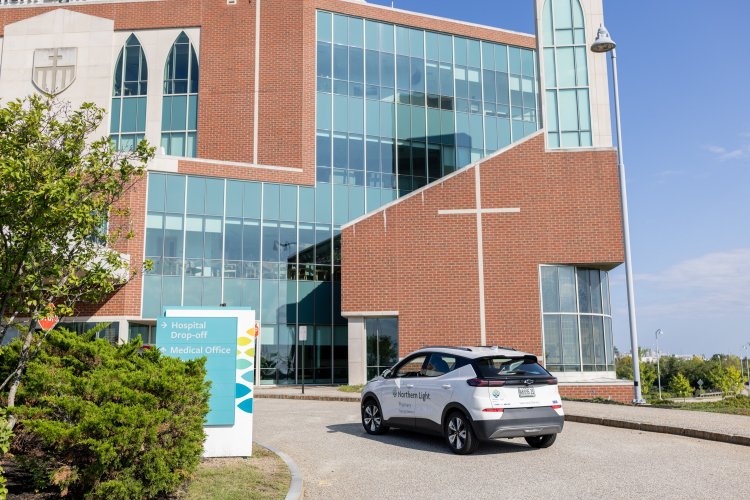

Adam Jordan, a pharmacist with Northern Light, drives the pharmacy’s electric vehicle past the hospital on Friday, Brianna Soukup/Staff Photographer
Maine’s hospitals are launching key environmental sustainability initiatives, to reduce their greenhouse gas emissions in the battle against climate change.
Hospitals don’t display obvious signs of being polluters – for instance, they don’t have towering industrial smokestacks that blow plumes of smoke into the air – but they are among the top energy users.
Tim Doak, chief environmental sustainability officer of Northern Light Health, said there are a number of reasons hospitals use a lot of energy: they are open 24/7, are often in older buildings with less efficient fuel systems (especially in Maine), use a lot of disposable products and require a lot of air circulation.
The U.S. health care system is responsible for 10% of the nation’s carbon emissions, according to a Yale University analysis, ahead of other sectors that are known for polluting, such as the aviation industry.
“Hospitals are part of the problem, historically,” Doak said. “Hospitals are very, very energy intensive. But we are now moving in the right direction.”
The U.S. produces 27% of global carbon emissions in the health care sector, the most of any country, according to Health Care Without Harm, an environmental advocacy group. China, despite having a much larger population than the U.S., is the second-largest, contributing 17% to carbon emissions.
Northern Light Health this year has eliminated the use of desflurane in all of its hospitals. Desflurane is an anesthetic gas that emits a tremendous amount of carbon dioxide on each use, and eliminating it reduces the system’s annual carbon dioxide emissions by 408 metric tons.
MaineHealth’s Maine Medical Center has also eliminated desflurane use, and will stop using it on all of its properties within the next few months, said John Porter, MaineHealth spokesman.
MaineHealth and Northern Light are the two largest health care systems in Maine.
Doak, of Northern Light, said they signed the Health Sector Pledge set up by the U.S. Department of Health and Human Services with a goal of reducing emissions by 50% by 2030 and becoming carbon neutral by 2050. About 15% of all hospitals in the U.S. – more than 1,100 in all – have signed the pledge since it launched two years ago.
Some of Northern Light’s initiatives that will help reduce emissions include using heat pumps to supplement or replace existing fossil fuel heating and cooling systems, replacing light bulbs with energy-efficient LED bulbs, composting food waste, converting gas-powered vehicles to electric vehicles, and purchasing sustainable supplies.
So far, about 15 vehicles in Northern Light’s 100-vehicle fleet have been converted to electric vehicles, with more expected in the near future, Doak said.
At Northern Light Pharmacy Fore River in Portland – located at the Mercy Hospital campus – pharmacy workers use a Chevy Bolt EV for pharmacy deliveries, and when they need to travel to other pharmacies, such as for a flu shot clinic.
“We use it every day,” said Adam Jordan, the pharmacist-in-charge at Fore River. “We deliver to independent living, doctor’s offices, home health care and hospice and if there’s referrals from other Northern Light practices.”
Doak said they are also considering adding solar as a renewable energy source.
Mary McCarthy, a nurse and associate vice president of supply chain programs and partnerships at Northern Light, said the system is working to buy “products from vendors that are environmentally and socially responsible in their manufacturing practices.”
McCarthy said for instance they are working on taking disposable products used in stitching up patients and for incisions, and having them reprocessed and reused rather than throwing them away. Used air mattresses that used to go to the landfill are now instead re-processed and sent back to Northern Light.
“We are substantially decreasing the amount of products we send to the landfill,” McCarthy said.
At MaineHealth, Kelly Elkins, the health system’s chief operating officer, said the system has started up many initiatives since 2022, with an overall goal of reducing emissions by 25% by 2027 and getting to carbon neutral by 2050.
“We wanted to do our part to minimize our emissions,” Elkins said. “We realize we’re large consumers of energy and large producers of emissions.”
Some of the initiatives include replacing lighting with LED bulbs, insulating old pipes, using renewable energy sources for heating and cooling, electric vehicles, reducing food waste, and eliminating desflurane gas. The goals even come down to making sure people use the most efficient driving route to get to a location and using as much sustainably sourced food for cafeterias as possible.
Northern Light launched the Maine Health Care Climate Collaborative this year, with so far about 75% of health care systems joining.
MaineHealth has joined Practice Greenhealth, a national organization where hospital systems share ideas on how to cut emissions.
But Jodi Sherman, director of the Yale Program on Health Care Environmental Sustainability, told STAT News in 2022 that more needs to be done on the regulation side, because “voluntary measures are not going to get us there fast enough, far enough.”
(Except for the headline, this story has not been edited by PostX News and is published from a syndicated feed.)

